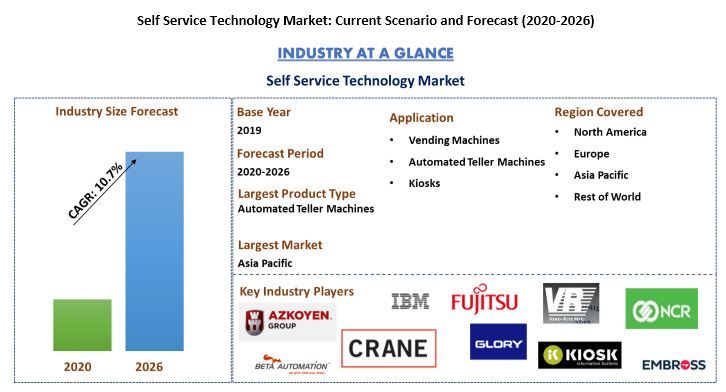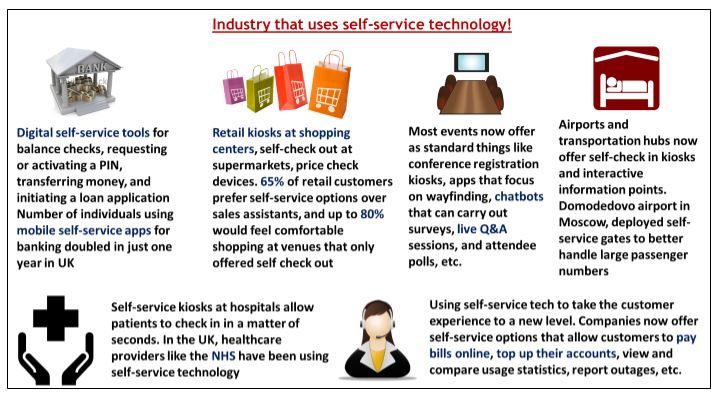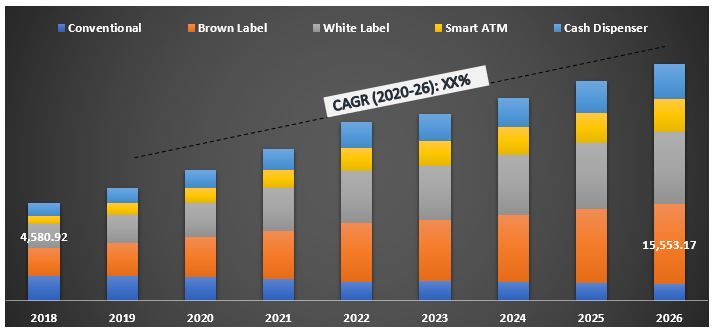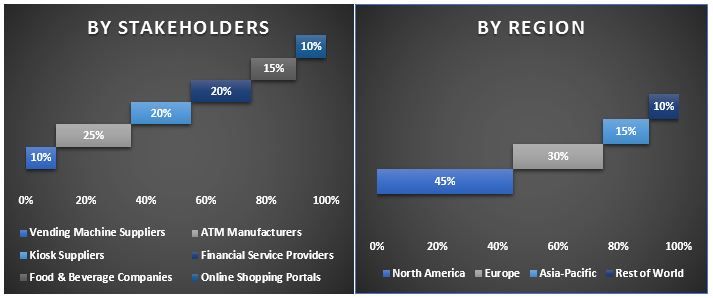- Home
- About Us
- Industry
- Services
- Reading
- Contact Us
Self-Service Technology Market: Current Scenario and Forecast (2020-2026)
Emphasis on Product Type (Vending Machine, Automated Teller Machine, Kiosks), Vending Machine Type (Beverage, Candy, Snacks, Gumball, Cigarette), ATM Type (Conventional, Brown Label, White Label, Smart ATM, Cash Dispenser), Kiosks Type (Photo, DVD, Ticketing, HR& Employment, Patient Self Service, Information Providing, Banking & Financial, Specialized), Solution Type (Deployment, Managed Services) and Region/Country
The Global Self Service Technology Market generated revenue of US$ 26.56 billion in 2019 and is expected to grow at a CAGR of 10.7% during the forecast period 2020-2026, to reach a market size of US$ 56.8 billion by 2026. Today’s fast-paced world is being increasingly characterized by technology-facilitated transactions. Today, customers prefer to interact with technology to create service outcomes instead of interacting with a service provider. With the rapid growth of technologies, various innovations are introduced in order to facilitate people’s needs and necessities. One of the innovations that have gathered great popularity among customers is Self-Service Technologies (SSTs). Self-service technologies (SSTs) are technological interfaces that enable customers to produce a service independent of direct service employee involvement. Major self-service technologies include automated teller machines (ATMs), automated hotel checkout, banking by telephone, and services over the Internet, such as Federal Express package tracking and online brokerage services. To add on, digital transformation has tremendously changed the interaction between the company as well as customers and service offerings. Developments in technology such as smartphones and IoT have also surged the need for instant fulfillment among consumers. Over time, self-service technology has grown from being an alternative way of handling certain tasks to becoming a primary channel given the benefits it entails. Some of the benefits associated with Self-Service Technologies are stated below:
- Convenience, both for the user and for the service provider: Lifestyle changes started during the second half of the 20th century meant that customer has become busier than ever and time is considered a valuable asset, so anything that saves time is considered a welcome addition
- The growing importance of delivering experiences: service providers view self-service technology as an opportunity to improve levels of customer satisfaction (and therefore retention) by using it to create products and services with an experiential focus
- Cost-effective: Self-service technology makes economic sense given the lower cost of online interactions vs frontline staff
- Demographic changes: Millennial generation and other digital natives feel at ease handling self-service technology
- Changes in expectations of Consumers: nowadays, most consumers prefer hands-on experience and a more interactive approach to technology that offers convenience and speedy transactions
- Self-service technology reflects the 24/7 culture we now live in, the evolution of self-service technology is almost a natural result of recent changes in society and in the business world
Numerous service providers are using a wide range of technologies to allow customers to consumer services or products electronically without direct contact. As self-service technologies are prominent in banking and financial services, in a similar fashion, food and beverage restaurants have also introduced self-service technologies mainly in the form of tablet computers in order to empower consumers to place orders and pay bills. Self Service technologies can also be found in the tourism and hospitality industry which are airline ticketing machines, automatic teller machines, and computer-based booking services. Further instances of SSTs in tourism and hospitality industry also include Ticket Vending Machine (TVM) for train and rail mode of transport, mobile application to book hotel rooms such as Trivago, Agoda.com and Booking.com, navigation application such as WAZE for directions, check-in kiosk in hotels, self-service kiosk for food ordering, and self-service information terminal usually found in a mall. Furthermore, in the retail industry, surveys show that more than 65% of retail customers prefer self-service options over sales assistants, whereas other studies suggest that up to 80% of surveyed shoppers would prefer shopping at venues that only offered self-check-out. It has been anticipated as per the survey that more than 85% of companies expect that self-service will be the fastest-growing channel in customer service by 2021 across the globe. However, lack of understanding encompasses to be the prominent bottleneck hampering the flourishing trend of self-service technologies. For instance, in the present scenario, connected consumers have high expectations of the brands they deal with. It has been found that over half i.e. 53% of US adults are likely to abandon an online purchase if they can’t find a quick answer to their question. Also, around 45% of consumers stated they’d spend just 5 minutes searching for information on a company website before giving up and going elsewhere.
“ATM segment dominated the Global Self-service technology market, with 82.2% share in 2019”
Based on the product category, the global self-service technology market is segmented into vending machines, ATM and kiosks. In 2019, the ATM segment dominated the market and is expected to maintain its dominance throughout the forecast period 2020-2026. However, the Kiosks segment is expected to witness the highest CAGR growth of 14.1% during the analyzed period. These technology-based interactions are expected to become a key criterion for long-term business success.
“Beverage Vending Machine-generated revenue of US$ 943.41 million in 2019”
Vending machine product category is further bifurcated into the beverage, candy, snacks, gumball, cigarette and specialized product vending machines. Candy vending machine-generated revenue of US$ 991.59 million by 2026. specialized product vending machines are expected to witness a CAGR growth of 11.5% during the forecast period.
“Brown Label ATM dominated the ATM segment of the Global Self-service technology market in 2019”
Global Self-service ATM segment is further bifurcated into the conventional, brown label, white-label, smart ATM and cash dispenser. In 2019, Brown Label ATM generated revenue of US$ 6,447.24 million and is expected to grow at a CAGR of 12.3% during the analyzed period. Smart ATM segment is expected to witness the highest CAGR growth of 14.8% during the forecast period 2020-2026.
ATM Market, by ATM Type, Global 2018-2026 (US$ billion)
“Ticketing Kiosk dominated the Self-service kiosks segment market, accounting for 40.7% share in 2019”
Based on the kiosk product category, the market is bifurcated into the photo, DVD, ticketing, HR& Employment, patient self-service, information providing and banking and financial kiosks. The patient Self-service segment is expected to generated revenue of US$ 354.59 million by 2026. The banking & Financial kiosks segment is expected to witness the highest CAGR of 16.5% during the forecast period.
“Asia-Pacific dominated the Global Self-service technology market in 2019”
For a deep-dive analysis of the industry, detailed country-level analysis is conducted for major region/country including North America (US, Canada, Rest of North America), Europe (Russia, Germany, UK, France, Spain, Italy, Rest of Europe), Asia-Pacific (China, Japan, India, South Korea, Singapore, Malaysia, Rets of Asia-Pacific) and Rest of the World. Asia-Pacific generated revenue of US$ 9,726.81 million in 2018 and is expected to witness a CAGR growth of 12.0% during the forecast period 2020-2026. Rising urban population paired with the demand for time-saving technology in countries such as India, China and other emerging Asian countries would help the region to remain dominant during the forecast period.
Competitive Landscape-Top 10 Market Players
Azkoyen Group, Kiosk Information System, Crane Corp, Fujitsu, IBM, Glory Ltd, Vendrite, Embross, NCR Corporation, Beta Automations, are some of the prominent players operating in the self-service technology industry. Several M&A’s along with partnerships have been undertaken by these players to facilitate costumers with hi-tech and innovative products.
Reasons to buy:
- Current and future market size from 2020 to 2026 in terms of value (US$)
- Combined analysis of deep-dive secondary research and input from primary research through Key Opinion Leaders of the industry
- Country-level details of the overall consumption of Self-Service Technology
- A quick review of overall industry performance at a glance
- In-depth analysis of key industry players
- Detailed analysis of export & import scenario of the industry
- A detailed analysis of regulatory framework, drivers, restraints, key trends and opportunities prevailing in the industry
- Examination of industry attractiveness with the help of Porter’s Five Forces analysis and start ups
- The study comprehensively covers the market across different segments and sub-segments of the market
- Region/country Covered: North America (US, Canada, Rest of North America), Europe (Russia, Germany, UK, France, Spain, Italy, Rest of Europe), Asia-Pacific (China, Japan, India, South Korea, Singapore, Malaysia, Rets of Asia-Pacific) and Rest of the World
Customization Options:
UMI understands that you may have your own business need, hence we also provide fully customized solutions to clients. The Global Self Service Technology market can be customized to the country level or any other market segment.
Table of Content
Analyzing the historical market, estimation of the current market and forecasting the future market for Self-Service Technology were the three major steps undertaken to create and analyze the adoption trend of Self-Service Technology across various industry verticals in major regions/countries globally. Exhaustive secondary research was conducted to collect the historical market size to estimate the current market for technology. Secondly, to validate these insights, numerous findings and assumptions were taken into consideration. Moreover, exhaustive primary interviews were conducted with industry experts across the value chain of the Self-Service Technology sector. Post assumption and validation of market numbers through primary interviews, a bottom-up approach was employed to forecast the complete market size of the technology. Thereafter, market breakdown and data triangulation methods were adopted to estimate and analyze the market size of segments and sub-segments the industry pertains to. Detailed methodology is explained below:
Analysis of Historical Market Size
Step 1: In-Depth Study of Secondary Sources:
Detail secondary study was conducted to obtain the historical market size of the self-service technology through company internal sources such as annual report & financial statements, performance presentations, press releases, etc., and external sources including journals, news & articles, government publications, competitor publications, sector reports, third-party database and other credible publications. For economic data collection, sources such as Trading Economics, Trade Map, World Bank, IMF, FAO among others were used.
Step 2: Market Segmentation:
After obtaining the historical market size of Self-Service Technology, a detailed secondary analysis was conducted to gather historical market insights and share for different segments & sub-segments for major regions/countries globally. The report segments the global Self-Service Technology market based on product category, product type and solution type. The further country-level analysis was conducted to analyze the overall adoption and penetration of the technology in that particular country.
Step 3: Factor Analysis:
After acquiring the historical market size of different segments and sub-segments, detailed factor analysis was conducted to estimate the current market size of self-service technology. Factor analysis was conducted using dependent and independent variables such as increased demand for convenience and ease, increasing awareness for technological advancements, changing lifestyles and rapid economic development. The demand and supply-side scenario were also thoroughly studied by considering top partnerships, merger and acquisition, business expansion, product launches and analyzing the list of start-ups in the self-service technology sector across the globe.
Current Market Size Estimate & Forecast
Current Market Sizing: Based on actionable insights from the above 3 steps, we arrived at the current market size, key players in the self-service technology market and market shares of these players. All the required percentage shares split, and market breakdowns were determined using the above-mentioned secondary approach and were verified through primary interviews.
Estimation & Forecasting: For market estimation and forecast, weights were assigned to different factors including drivers & trends, restraints, and opportunities available for the stakeholders. After analyzing these factors, relevant forecasting techniques i.e. bottom-up approach was applied to arrive at the market forecast pertaining to 2026 for different segments and subsegments across major regions/countries globally. The research methodology adopted to estimate the market size encompasses:
- The industry’s market size, in terms of value (US$) and the adoption rate of self-service technology across the major regions/countries
- All percentage shares, splits, and breakdowns of market segments and sub-segments
- Key players in the self-service technology market in terms of the services offered as well as market share. Also, the growth strategies adopted by these players to compete in the fast-growing market
Market Size and Share Validation
Primary Research: In-depth interviews were conducted with the Key Opinion Leaders (KOLs) including Top Level Executives (CXO/VPs, Sales Head, Marketing Head, Operational Head, and Regional Head, Country Head, etc.) across major regions/countries. Primary research findings were then summarized, and statistical analysis was performed to prove the stated hypothesis. Inputs from primary research were consolidated with secondary findings, hence turning information into actionable insights.
Split of Primary Participants in Different Regions
Market Engineering
Data triangulation technique was employed to complete the overall market estimation and to arrive at precise statistical numbers for each segment and sub-segment pertaining to the self-service technology market globally. Data was split into several segments & sub-segments post studying various parameters and trends in the areas of product category, product type, solution type of self-service technology.
Main objective of the Self-Service Technology Market Study
The current & future market trends of self-service technology are pinpointed in the study. Investors can gain strategic insights to base their discretion for investments from the qualitative and quantitative analysis performed in the study. Current and future market trends were determined the overall attractiveness of the market at a regional/country level, providing a platform for the industrial participant to exploit the untapped market to benefit as a first-mover advantage. Other quantitative goals of the studies include:
- Analyze the current and forecast market size of the self-service technology in terms of value (US$). Also, analyze the current and forecast market size of different segments and sub-segments
- Segments in the study include product category, product type, solution type
- Define and analysis of the regulatory framework for self-service technology
- Analyze the value chain involved with the presence of various intermediaries, along with analyzing customer and competitor behaviors pertaining to the industry
- Analyze the current and forecast market size of the self-service technology market for the major regions/countries including North America (US, Canada, Rest of North America), Europe (Russia, Germany, UK, France, Spain, Italy, Rest of Europe), Asia-Pacific (China, Japan, India, South Korea, Singapore, Malaysia, Rets of Asia-Pacific) and Rest of the World
- Define and analyze the competitive landscape of the self-service technology and the growth strategies adopted by the market players to sustain in the fast-growing market
- Deep dive export & import scenario of the industry
Related Reports
Customers who bought this item also bought














